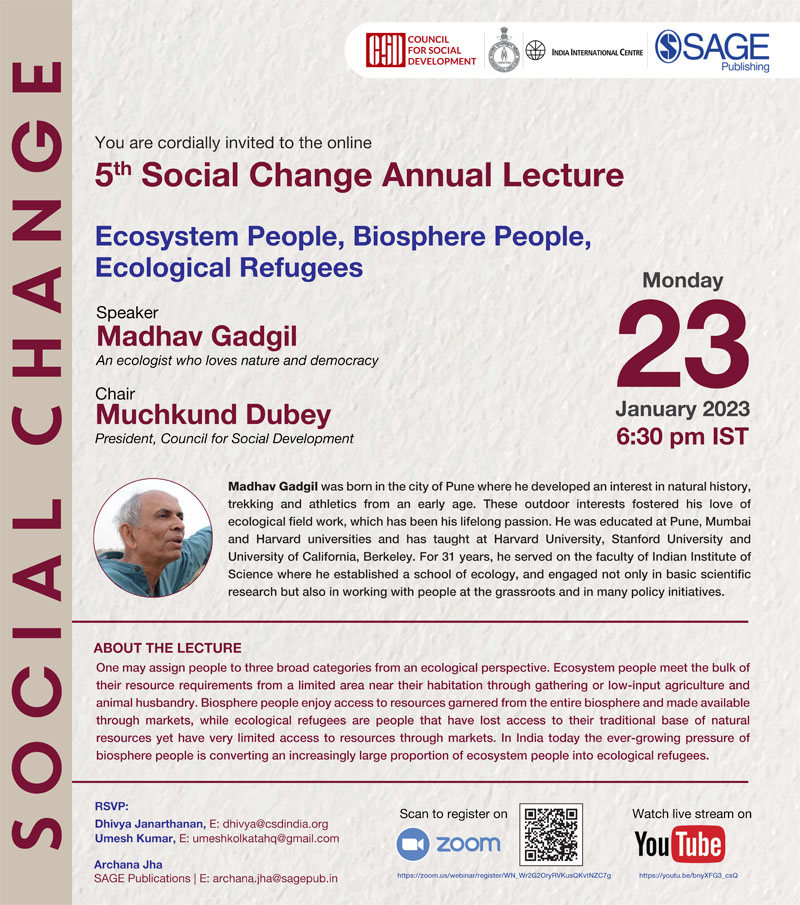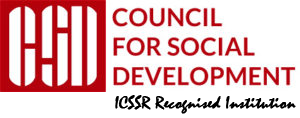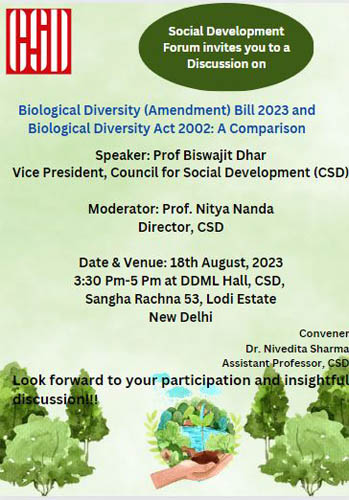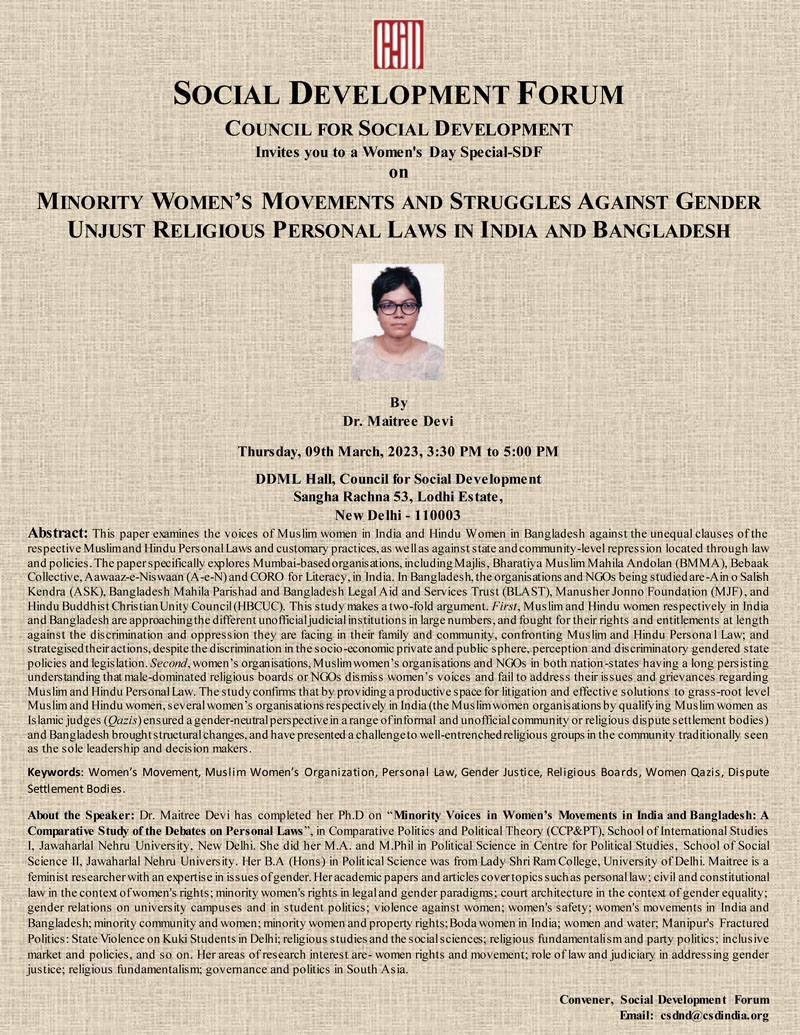Galvanising the Ship of the Indian State: An Agenda for Research and Dialogue
Monday, 31st July, 2023, 3:00 PM to 6:00 PM
DDML Hall, Council for Social Development
Sangha Rachna 53, Lodhi Estate, New Delhi – 110003
Chair: Prof. Muchkund Dubey, President, CSD
Author: Prof. Saurabh Kumar, Visiting Professor, CSD
The accomplishments of the post-independence Indian State can be assessed as good but not good enough; impressive w.r.t. the state of stasis the nation was in under colonial rule yet underwhelming w.r.t. its founding vision and charter — of Sarvodaya through Antyodaya, if they could be so described in capsule form, and of the raison d’etre of the newly founded State being, in the lyrical words of its first Prime Minister, to (be able to) better “wipe (away) every tear from every eye”. India does not come out on top in comparison to the perform-ance of many other developing countries either, China – its only peer in the comity of nations – above all.
That mixed record is the trigger for this Essay, a strategic take on the future prospects of the Indian Republic. So also the new demands on the State machinery stemming from the multi-faceted challenges of climate and AI driven disruptive technological change, and from the state of flux the geo-political and geo-economic environment in India’s neighborhood, ‘near abroad’ and globally is in, which add to the gravity and complexity of the situation. (The challenge of the Chinese Party State galloping ahead, in the undeclared contest between the two nations for ‘Comprehensive National Power’, with its own (a)ideological, ‘results-oriented’ model of ‘neo-liberal’ “socialism with Chinese characteristics”, oxymoronic or whatever, most of all.)
The Paper posits that structural reform, going beyond mere governance reform and policy innovation, will be called for if the delivery capacity of the State machinery (its “structuration and apparatuses”, in the words foregrounded by the noted scholar, Prof. Upendra Baxi) is to be augmented; not just to be brought on par with other high performing nations but, more importantly, to be able to effectively stem the ever-deepening ‘India-Bharat’ dualism by developing capabilities for servicing the basic (human) needs of ‘Bharat’ efficaciously.
It takes the form of a ‘Concept Note’ of a proposal for a study/research-cum-dialogic project for a critical review of the experience of 75 years of the Republic aimed at identifying structural factors that impede optimal performance and remedies for overcoming them. A ‘strategic management’ approach is advocated in respect of the latter (perking up State institutions to make them more functional), viz. not taking existing structures as immutable, while devising ways and means of streamlining and fine-tuning prevailing procedures and arrange-ments for enhanced effectiveness, not excluding a remodeling of the institutional architecture if necessary.
The discussion meeting is envisaged, inter alia, as a brainstorming session for getting the Study part of the project (Section V pgs. 27-33) off the ground, as in the concluding section (Section VIII, Pg. 43).
Looking ahead, the project is expected to throw up a crisp agenda for structural reform of the Indian Republic, thought through thoroughly, pragmatically from the feasibility angle in the course of a ‘Strategic Dialogue’ between key constituencies of the national polity. One that would, hopefully, be ripe for being tossed into the political arena as a contribution to State-building by the intelligentsia, as a strand of statecraft — ever a work-in-progress in any nation-in-the-making — for the political class to mull over.
Academic Autonomy Needed a Holistic Societal Perspective
There are different kinds of institutions of Higher Education in India implementing varying concepts of autonomy. Privately funded institutions mostly work with a narrow view of autonomy. Even those of them that have had a more liberal view of it have been forced to fall in line, due to implicit pressure from the ruling dispensation. The institutions run with government funding have also inevitably lost whatever autonomy they had. The publicly funded universities theoretically can offer greater protection to academics but with few exceptions even they have substantially regressed in the last few decades.
This is a result of growing political pressure and bureaucratization of institutions of Higher Learning. The role of the head of Institutions is crucial in protecting the institution’s autonomy. However, often a narrow view of autonomy is adopted which grants it to the head but not to the academics. Those outside then can control the system for their ends. Society has little idea of these developments and therefore does not react to loss of autonomy of institutions.
In brief, the loss of autonomy in India is an ongoing process due to a lack of wider understanding of the issues. So, it is argued that autonomy is a societal issue requiring a holistic understanding and action.
Read More
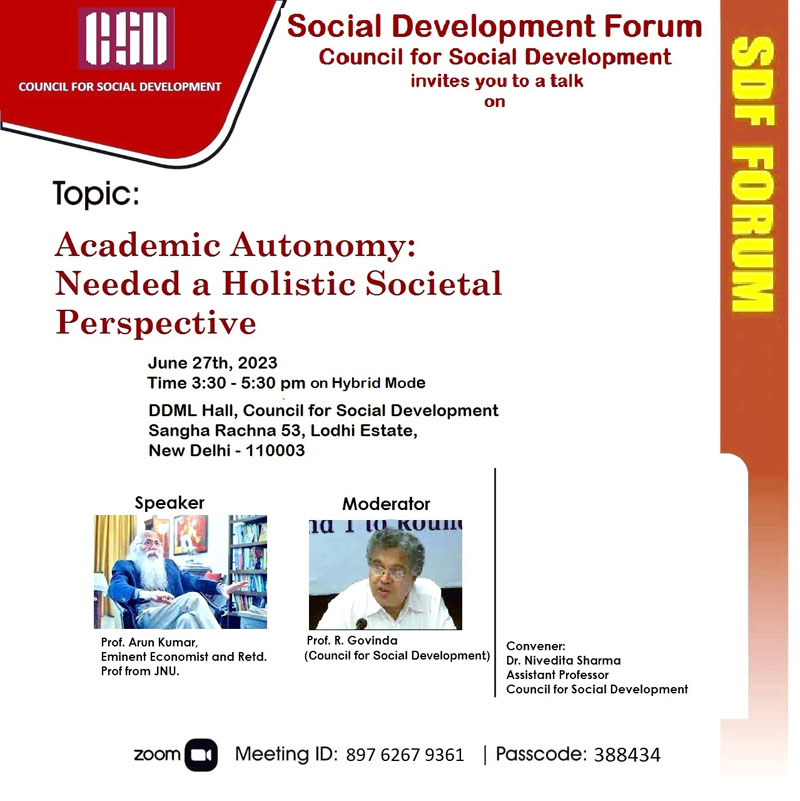
Bandung Day Symposium 2023
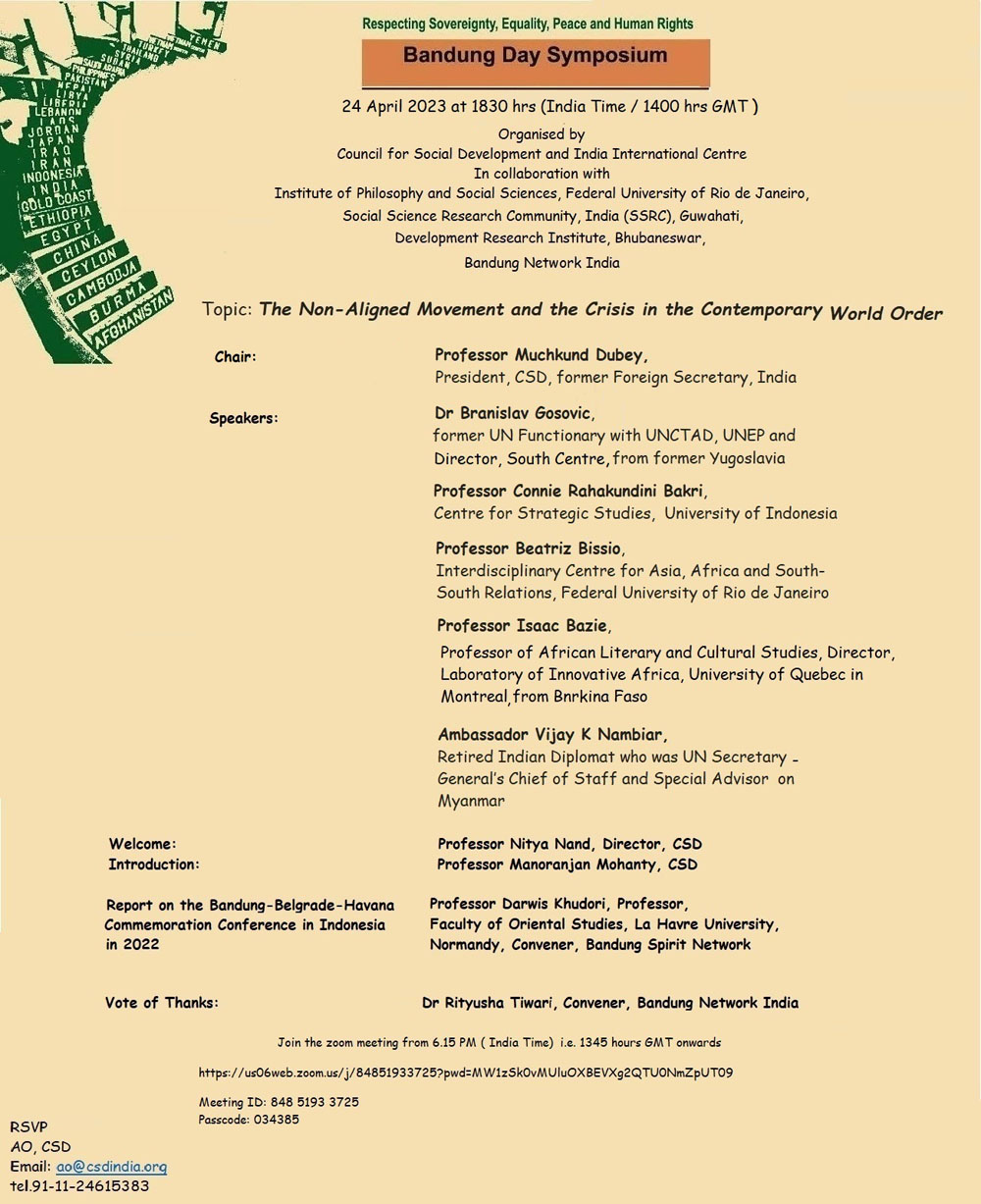
Join the Zoom Meeting from 6.15 PM ( India Time) i.e. 1345 hours GMT onwards.
https://us06web.zoom.us/j/84851933725?pwd=MW1zSk0vMUluOXBEVXg2QTU0NmZpUT09
Meeting ID: 848 5193 3725
Passcode: 034385
SDF Women’s Day special
Title: Minority Women’s Movements and Struggles Against Gender Unjust Religious Personal Laws in India and Bangladesh”
Speaker: Dr. Maitree Devi
Date: 9 March, 2023
Time: 3.30 -5.00 PM
Venue: DDML Hall, CSD
Link to Zoom Meeting
https://us06web.zoom.us/j/83777313489?pwd=ekhsMWptblNqVldNRTR6Y1Y3Vjl3dz09
Meeting ID: 837 7731 3489
Passcode: 441475
Rescheduling of the Workshop on Capacity Building for Resettlement and Rehabilitation of Project Displaced People
February 27-28, 2023
At
India International Centre, New Delhi
Objectives:
- to familiarize the participants with the complex issues surrounding land acquisition and resettlement
- to develop among them ability to do Social Impact Assessment and resettlement planning
- to enhance implementation and monitoring skills.
Participants:
- senior/middle level government officials,
- industry managers,
- NGOs,
- academics, and
- those working on internationally-funded projects.
Course Contents:
- Land Acquisition Law and Rehabilitation Policy: A Historical Perspective
- Land Rehabilitation and Resettlement Act 2013: Background, Context and Implementation
- Social Impact Assessment
- Environmental Impact Assessment
- Tribal and Gender Issues in Resettlement Projects
- Social Movements against Displacements
- Resettlement and Rehabilitation: Case Studies
- Relocation and Resettlement in Urban Areas
- Best Practices in Resettlement & Rehabilitation
Course Contribution:
Revised Contributory Fee: INR 5,000;
Concessional Rates for Students and NGOs: INR 3,000
Need-based modest accommodation will be provided to a limited number of outstation participants.
Last date for receiving application/nominations is 5 February 2023.
For further information, please contact
Dr Nivedita Sharma
Assistant Professor
Council for Social Development, Delhi
Phone: 011-24692655/234
Email: nivedita@csdindia.org
Training Programme on Research Methodology in Social Sciences
Dates: 11-22 April 2023
The last date for applying has been extended to 6th April, 2023
The Council for Social Development (CSD), New Delhi, is organising a Twelve-day Training Programme on Research Methodology in Social Science for M.Phil./Ph.D. Scholars of Indian Universities, colleges and academic institutions and professionals working in the field of social development from 11-22 April 2023.
The objective of the programme is to provide understanding of various aspects of research methodology including research design, quantitative and qualitative methods, data preparation, empirical analysis, academic writing and interpretation. The programme seeks to i) discuss conceptual issues on emerging areas of social science research; ii) improve skills and the ability to undertake research on those issues using appropriate datasets, statistical tools and methods and estimation procedures; and iii) discuss the nature of research dissemination. The methodology programme will consist of lectures by eminent academicians, group discussions besides hands-on experience with datasets using statistical techniques.
The target group of the programme is young social science researchers who are enrolled for M.Phil./Ph.D. in a UGC recognized university/deemed university/colleges/institutes of national importance and ICSSR Research Institutes and professions working in the field of social development. A batch of 30-35 participants will be selected on an all-India basis from various disciplines of social sciences.
Broad Themes included in the Course
- Introduction to Social Science Research and research process, theoretical perspectives in social science research, Notions of Objectivity and subjectivity in Social Science Research
- Reviewing literature
- Qualitative and quantitative research designs, methods, and instruments
- Analysis and interpretation of quantitative and qualitative data as well as mixed methods research
- Formulating research questions
- Pre-requisites and preparation for qualitative and quantitative research, Research ethics and integrity
- Tools for Data Collection, Interview Schedule and Questionnaire, Case Study and Observation
- Principles and techniques of statistical analysis
- Statistical tools and Statistical Packages for Social Sciences, MS EXCEL and STATA
- Building Academic writing skills
Learning outcomes
Upon the completion of the course, the participants will:
- Understand research terminology
- Be aware of the ethical principles of research, ethical challenges and approval processes
- Describe quantitative, qualitative and mixed methods approaches to research
- Identify the components of a literature review process
- Critically analyze published research
- Be able to write high quality research proposals, thesis/ dissertations, study reports and research papers.
Other Details
Course Contribution: The contribution from each participant is Rs 7000/- which covers the cost of course material, lunch, tea/coffee.
The Course contribution can be paid by Demand Draft/Crossed Cheque, favouring ‘Council for Social Development’ payable at Delhi. Alternatively, online fund transfer can be made to the Council’s Account, by way of NEFT.
The details are as follows:
Name of the Bank: Bank of India
Branch: Khan Market, New Delhi
Full Name of Account: Council for Social Development
Account Number: 600720100050048
Swift Code: BKIDINBBKHM
IFSC Code: BKID0006007
Micr Code: 110013014
Reference Description: Main Account
Type of Account: Current Account
The participants will have to make their own arrangement for travel and accommodation.
Interested candidates may fill the application form and submit it through email to jaya@csdindia.org on or before March 25, 2023 with the subject line ‘Application for CSD- RMC 2023’. Alternatively, they can post the application form to Ms Jaya Nair by super scribing ‘Application for CSD- RMC 2023’.
Selected candidates will be informed by April 2, 2023.
For further query, email: jaya@csdindia.org.
Budget Seminar: Decoding the Union Budget 2023-24
The seminar on Union budget 2023-24 was organised by Council for Social Development (CSD), New Delhi in hybrid mode on 6th February 2023. The speakers were Prof (retired) C P Chandrasekhar from JNU, Dr Satyaki Roy from ISID, Prof Muchkund Dubey, President CSD; Dr Pritam Datta from NIPFP, Prof Vikas Rawal from JNU, Mr Harvir Singh, eminent journalist; Prof K B Saxena, distinguished professor at the CSD; and Prof Nitya Nanda, Director, CSD New Delhi.
Two conspicuous signals come out of the UB 2023-24. First, there is a significant step-up in the capital expenditure from about Rs. 7.3 lakh crores last year to around Rs. 10 lakh crores in the upcoming year; and second, emphasis on fiscal consolidation i.e. reduction in fiscal deficit from 6.4 per cent in 2022-23 to 5.9 per cent in 2023-24. The fiscal deficit is projected to be brought down to 4.5 per cent of the GDP in FY 2024-25 and gradually to 3 per cent of the GDP. However, it is difficult to predict that the target set for the fiscal deficit for the FY 2023-24 will be achieved by the end of the year because of the uncertain nature of allocations for demand-based programmes. For example, in MGNREGA, increase in the demand for work will also increase the public expenditure.
Considering the attempts of the government towards reduction in fiscal deficit and the absence of any wealth tax levied on the rich in India, increase in public expenditure will be financed through resources like CESS (like that on oil and oil products), and national infrastructure and rural fund which have come in handy over the last few years for this purpose.
The Finance Minister has projected a nominal growth rate of 10.5 per cent for FY 2023-24 while the Economic Survey estimated the real growth rate of 6.5 per cent for the same year. So, the implicit inflation is around 4 per cent. Pre-pandemic and post-pandemic data in constant prices show that the post-pandemic recovery has happened in a modest form. Employment in the informal sector has significantly declined in the post-pandemic years and India has not recovered much from the contraction in employment opportunities. The Economic Survey 2022-23 cites in favour of its thesis of full recovery the example of credit off-take by the industries. However, credit off-take data show credit to the MSME sector actually declining after an increase in the initial period of FY 2022-23.
There is a big hype about the increase in the Union budget in capital expenditure. In fact, the thrust on capital expenditure was also there in FY 2022-23. But the revised estimate (RE) in FY 2022-23 shows that CAPEX was less by Rs. 90,000 crore than the budgeted allocation at budget estimate stage. So there is no guarantee of spending the increased budget on capital expenditure in the coming year. The Economic Survey 2022-23 states that the real wage rates in the agriculture as well as non-agricultural sector have declined. On the other hand, profits of corporate houses have increased significantly during the same period leading to increase in inequality during the period.
A reduction in subsidies for petroleum products and fertilizers will have a cascading effect on prices and therefore we may witness a further rise in inflation. Monopolists who can include the input cost in the commodity prices may benefit in all likelihood from the increased inflation. The government will also be benefitted in terms of increased GST collection as a result of increased commodity prices. On the other hand, poor working class will be adversely affected of inflationary tendencies in the economy for two reasons: decline in real wage rates and increased prices of essential commodities.
The present Union budget provides some benefits to the middle-class in the form of increase in the ceiling of taxable income for those having an annual income upto Rs. 15 lakhs. However, only around 6 per cent of the population fall in the income tax bracket. On the other hand, the Union budget will put more burden on the 94 per cent of the population who are out of the income tax bracket. They will not receive any benefit arising out of the tax cut but will be required to bear the larger burden imposed on them by the proposals in the budget such as curtailment in food subsidies and fund cuts for health and education. Thus, this budget might not address the problems of people who suffered the most due to the COVID-19 pandemic.
Health Sector in the Union Budget 2023-24: The health sector has not received adequate focus in this year’s budget speech of the FM, unlike in the previous two years. However, there are a few positive points worth noting. There is announcement on establishment of 157 nursing colleges, Mission to eliminate Sickle Cell Anaemia by 2047, encouraging collaborative research and innovation by making selected ICMR labs available for public and private medical college faculty and private sector R&D teams, promotion of research and innovation in pharmaceuticals through centers of excellence, encouraging multidisciplinary courses for medical devices etc. The announcement that sickle cell anaemia will be eradicated by 2047 is a positive step but there is no mention in the budget document of any fund allocation to be made in FY 2023-24 for eradicating sickle cell anaemia. The health ministry, though, has clarified that it will be a part of the National Health Mission (NHM). The announcement needs to be seen in juxtaposition with the similar announcement about other diseases in the past years. The deadlines for eradicating other diseases have already been passed or extended multiple times. For instance, the elimination deadline for Filariasis and Kala Azar was 2017 and 2020 respectively which have been revised to 2023 and 2030 respectively.
Total allocations for the Ministry of Health and Family Welfare stood at Rs. 89.2 thousand crores, which is 3 per cent higher than the last year’s allocation. This in real terms is less than the allocations in FY 2022-23. The budget for the Ministry of AYUSH has been increased by 20 per cent from Rs. 3.1 thousand crores in 2022-23 to Rs. 3.6 thousand crores in 2023-24. Expenditure on Health is 2.4 per cent of total union budget in 2023-24 as against 2.7 per cent in 2022-23 and 3.6 per cent in 2021-22.
The 11th Five-year plan had recommended scaling up of government health spending to at least 2 per cent of GDP by 2012. National Health Policy 2017 recommended increasing public health spending to 2.5 per cent of the GDP by 2025. The Union health budget is, however, only 0.35 per cent of the GDP in 2023-24, 0.42 per cent in 2022-23 and 0.56 per cent in 2021-22.
Education in the Union Budget 2023-24: As in previous years, Finance Minister did not make even a passing reference to school education let alone providing adequate resources for realising the goal set in the Right to Education Act for universalising elementary school education. The RTE Act thus continues to remain neglected. There were serious deficiencies in its implementation even before the commencement of the Pandemic. The union budget has not addressed the real needs i.e. universalization of school education and improvement in the quality in school education. Only 12 per cent of the schools were compliant with all the norms of infrastructure laid down in the RTE Act (2009). Numbers of children out-of-school are in crores. These children were supposed to be brought back to schools within three years after the enactment of the legislation, i.e. by the year 2012. Universalization of education was planned to be done within five years of the legislation i.e. by the year 2014. There were some structural deficiencies within the Act itself, like leaving out children below the age of six, and between the age group of 15-18 years. If the proportion of children in the secondary education remains limited, the number of students going to higher education institutions will be even less. This will make the entire system inequitable as most of the children, particularly those coming from poor households will drop out after finishing their primary education. This will also limit India’s chances of competing in the world market.
For the children below the age of six years, ICDS was the only programme running since 1975. But this programme is voluntary and not legally binding. Despite Supreme Court’s directive that it should be universalized, since its establishment, no deadline has been fixed or required resources provided for achieving this goal. Both the National Education Policy and the budget speech highlight that education in early childhood is important but it seems just rhetoric.
MGNREGA in Union Budget 2023-24: Allotment for MGNREGA in FY 2023-24 is 18 per cent lower than the budget estimate for the FY 2022-23 and 13 per cent lower than the revised estimate. It is less than 0.2 per cent of GDP, the lowest ever. World Bank economists have estimated that the allocation should be 1.6 per cent of the GDP. The amount allotted to the programme in FY 2023-24 is Rs. 60,000 crores as against the revised estimate of Rs. 89,400 crores for the FY 2022-23 and the estimate of Rs. 73,000 crores in the budget estimate of the current year. This amount is the lowest since 2016-17. This is in spite of the fact that the average days of employment provided per household under the Scheme is at a five year low in the current financial year. The Government also forgot that it was MGNREGA that helped in staving off starvation on a large scale during the Pandemic years. If the wages pending from the last financial year amounting to a little over Rs. 16,000 crores and the current rate of inflation are taken into account, then in real terms allocation for MGNREGA in the budget will be less than Rs. 45,000 crores.
According to a statement issued by the People’s Action for Employment Guarantee and MGNREGA Sangharsh Morcha, a budget of Rs. 2.72 lakh crores will be required during the current year to meet fully the objective of legally guaranteed hundred days of work to all eligible households. Even giving each active household just forty days of work would require Rs. 1.42 lakh crores, more than double the current allocation.
Food and Agriculture in Union Budget 2023-24: Given the fact that output prices have remained high because of rising input prices in the agricultural sector, there is a need to inject money on the input side to keep the prices low and so allocations to the agricultural sector should have increased in the union budget. However, it has actually decreased in this year’s budget. The flagship scheme of the government; PM Kisan Sammaan Nidhi, has not been provided adequate funds.
There has been an incredible lack of coherence in the Union budget in the last few years. For instance, the Ujjawala scheme has a great potential for transforming the lives of rural women but no allocations have been made for the scheme in the recent years. Similarly, “har khet ko pani” through Krishi Sinchai Yojana was announced in 2018-19 but the scheme has been stopped now.
The Finance Minister was silent on the Government’s promise to double the real incomes of the farmers between 2015 and 2022. The budget for agriculture is lower than that allotted in the last budget. In real terms the provision in the budget represents a decline of 10 per cent. This has happened at a time when our agriculture sector is in distress due to the rising costs of energy and fertilisers mainly brought about by the Ukraine War. This situation is likely to get worse in the coming financial year. The Government should, therefore, have substantially increased the budget provision for agriculture in order to meet at least the looming crisis situation. There is a trend of secular decline in public investment in agriculture, at 0.6 per annum between 2016-17 and 2020-2021. The budget for the Ministry of rural Development at Rs. 1.5 lakh crores is 13 per cent lower than the revised estimate last year. The budget allocation for Agricultural Infrastructure Fund is Rs. 500 crores, the same as in the current financial year 2022-23. This is too small an amount for an important sector like agricultural infrastructure. The provision for food subsidy in the budget at Rs. 1.97 lakh crores represents a substantial cut from the provision for this item, amounting to Rs. 2.87 lakh cores in the 2022-23 budget.
The Government had earlier taken the decision to discontinue the Pandemic time supply of additional foodgrains amounting to 5 Kgs per persons per month through free ration allocation to the poor under the PM Garib Kalyan Yojana had come in for severe criticism from many quarters. In this budget, the Government has announced its intention to provide for one year their entitlement under the Food Supply Act. This sounds very generous but it is not enough to compensate fully the discontinuation of the Pandemic time supply of additional foodgrains.
In the ultimate analysis, the challenge in agriculture is to enhance productivity. This requires significant increase in investment in agriculture R&D. The budget for the Department of Agricultural Research and Education has been set at Rs. 950 crores, an increase of 9.7 per cent over the current financial year. This is too meagre a change to enable the nation to transform agriculture and produce enough foodgrains to feed people and keep inflation under control. There is, therefore, a compelling need to increase expenditure on agriculture R&D by a substantial amount in order to meet the looming crisis in agriculture.
Rural Development in Union Budget 2023-24: Rural economy is 50 per cent of the total economy but the Union budget has not accorded much significance to this sector. For rural development, there are two major ministries-Ministries of Agriculture and Farmers’ Welfare (MoAFW) and Ministry of Rural Development (MoRD). There is overall reduction in allocations for MoRD and MoAFW. There is major increase in allocations for PM Awas Yojana but the rural component of the scheme has not received much increase. The PM Kisan Samman Nidhi Yojana has also witnessed a reduction of Rs. 8,000 crore from the last year’s allocation. The capital expenditure in agriculture has been allocated only Rs. 52.83 crore. Agriculture research and education has also received only Rs. 20 crore. The National Agricultural Infrastructure Fund established in 2020 for agricultural development was allocated Rs. 1 lakh crore but so far only Rs. 500 crore have been utilised from this fund. There is no major allocation for Accelerator fund and PM Gram Sadak Yojana. PM Fasal Bima Yojana has seen a decrease in allocation by Rs. 1875 crores. The scheme is faulty in its design as private companies are making profits through this scheme. Several states are opting out of this scheme. Another instance is of PM Aasha which is the Prime Minister’s Farmer Income Protection Scheme. It was an umbrella scheme of the Government of India announced in September 2018 to ensure proper price policies such as a minimum support price. The scheme has been discontinued from this year. There was an expectation that the government would reduce GST on farm machinery and fertiliser sales. This has not happened in the budget. There is a lot of hue and cry over burning of stubble of paddy and Happy Seeder is suggested as an alternative. The government could have removed GST from the product to encourage farmers to use seeders but it has not happened in the budget.
Marginalised Sections in Union Budget 2023-24: Although the Finance Minister in her budget speech stated that the fruits of development in inclusive India will reach to all regions and social groups, particularly the youth, women and SCs and STs, the allocations for minorities’ development have been drastically reduced in the budget 2023-24. The FM mentioned that Deendayal Antyodaya Yojana National Rural Livelihood Mission has achieved remarkable success by mobilizing rural women into 81 lakh Self Help Groups (SHGs). These SHGs will be scaled up as producer groups which will produce goods for the global economy. But there is no evidence that these SHGs have performed to that level. For economic empowerment of women, the government should focus on programmes like MGNREGA. Nearly, 54 per cent of workers under MGNREGA are women. If enough employment is generated, it will partly solve the problem of empowerment. Even the allocation for the National Rural Livelihood Mission has not increased. This government has promoted dismantling of affirmative action programmes in terms of reservations in jobs. Over the years, particularly after economic reforms, number of vacancies in central sector establishments has been drastically reduced. Even if vacancies are created, these are contractual in nature. Public opportunities are, thus, declining. In terms of private sector employment, there is discrimination against SC and ST. There is ample evidence to suggest that people from SC and ST groups are generally not recruited.
The idea of setting up Panchayat Level Library is a good initiative but there is no allocation announced for this scheme. It was mentioned that states would be encouraged to set up such libraries. If there had been a real intention behind implementing this scheme, the government would have started this as centrally sponsored scheme under Ministry of Panchayti Raj. If it is only left to the state, then resource poor states will completely ignore it. Even for other states, this devolution of resources has been reduced. Thus, the states will not be able to implement this important measure. In regard to the allocations towards the Ministry of Tribal Affairs, there is a substantial allocation under Particularly Vulnerable Tribal Groups (PVTG). It is a welcome step as these are extremely neglected groups. There are around 75 PVTGs living in poor conditions and suffering from acute food insecurity and malnutrition. Each of this tribe is an isolated group and there cannot be one strategy for all PVTGs. There is a need of dedicated set of workers to closely monitor implementation of schemes for PVTG and each tribe should be taken up separately.
Announcement about financial Support for those who cannot get bail is a good initiative as around 66 per cent of under-trials in courts are from marginalised communities. Most of them do not get bail as they do not have resources. But financial support for getting bail is not the solution. Rather, bail should be granted on personal security or panchayat security. Mechanical desludging is a good idea but this scheme has ignored rehabilitation of the already existing manual scavengers. A social audit is necessary for skill development programme of Kaushal Vikas Yojana. Over the years, there is not much impact of this programme on employment generation, particularly for weaker sections.
Most of the victims of violence are people from weaker sections. In the case of SCs, number of crimes against them has increased from 42,793 to 50,291 between 2018 and 2020. Against STs, number of crimes has increased from 6528 to 8278 during these years. Similarly, crimes against women have increased from 3,38,954 to 4,58,273 over these years. In respect of rape cases, increase is from 28,153 to 31,870. For children, cases have increased from 1,28,531 to 1,49,404; an increase of 16 per cent over the two years. Reasons for such an increase are lack of special courts, bias in investigation and lack of social support. In case of allocations for schemes that provide support to such cases, no significant change is seen. Under “Sambal” scheme, help is provided for safety and security of women. But there is no increase in allocation in any of the component of the scheme. Allocations for four important programmes viz. Strengthening of Machinery for Enforcement of Protection of Civil Rights Act, 1995; Prevention of Atrocities Act, 1989; Strengthening of Machinery for Enforcement of Protection of Civil Rights Act, 1995 and Prevention of Atrocities Act, 1989 have not been increased in the union budget.
As highlighted in the PLFS data, there is a high rate of unemployment among these marginalised sections. The union budget has focussed on capital expenditure but big infrastructure creation will not create jobs. The PM Awas Yojana has a potential of creating jobs but the component for labour wages is only 15 per cent and the rest is material component. Hence, capital expenditure on big infrastructure projects is not a solution for tackling the issue of unemployment. The union Government is pushing towards credit based self-employment but not everyone can become self-employed or entrepreneur. On the other hand, MGNREGA which generates wage employment has seen a decline in allocation. There is also decline in number of days of employment generated in the programme.
Allocations for National Social Assistance Programme (NSAP), the only programme for providing social protection have been reduced by 15 per cent in the budget 2023-24.
Allocation towards the department of Persons with Disability is increased by a meagre 1.01 per cent and that towards the department of social justice and empowerment is increased by only 4.3 per cent (Rs 9.25 crore) from the last year’s allocation. Of all the ministries and departments with a mandate for empowering weaker sections, only the Ministry of Tribal Affairs has received a substantial increase of 70 per cent in comparison to last year’s allocation. And this is mainly because of increased allocations for PVTGs. There are total 29 schemes for weaker sections and 19 of these schemes have either their budget allocations reduced or remaining the same as the last year’s allocation.
The parliamentary committee has expressed distress that over the years number of SC students needing scholarships is declining. This is mainly because of the eligibility conditions which deprives a large number of families from taking benefits of such schemes. The annual income criterion has remained fixed at Rs. 2.5 lakh for the last eight years. This has effectively come in the way of utilization of the present meagre number of scholarships.
The budget allocation for the Ministry of Minority Affairs was reduced by 38 per cent. Several scholarships and skill development schemes got major fund cuts, including the merit scholarship for professional and technical courses for students from the minority community. The Scheme has been allotted Rs. 44 crores against the budget allocation of Rs. 365 crores last year.
The Finance Minister also slashed the funds for pre-matric scholarship for minorities by over Rs. 900 crores. The provision was reduced from Rs. 1425 crores in the last budget to Rs. 433 crores in the present one. The total allocation in the budget for educational empowerment of minorities was reduced from Rs. 2515 crores to Rs. 1689 crores.
In a massive fund cut, the allocation on educational schemes for madarsas and minorities was reduced by 93 per cent from the allotment of 160 crores in the last year’s budget to only Rs. 10 crores. Pradhan Mantri Jan Vikas Karyakram was initiated to develop socio-economic infrastructure and basic amenities in the identified minority concentration areas for improving the quality of life of the people residing there and reducing imbalances. The budget allocation for this was reduced from Rs. 1650 crores to Rs. 600 crores.
Overall, the proposals for minority communities in the present budget taken together may be regarded as the burial of the report of the Sachchar Commission on Minority Communities.
Social Development Forum talk on Women’s Labour and Welfare in the Extractive Industries
Social Development Forum Council for Social Development Invites you to a talk on
Women’s Labour and Welfare in the Extractive Industries: A Comparative Analysis of Coal and Iron Mining in India, 1941–2015
By Dr Dhiraj Kumar Nite, Ambedkar University Delhi
Date: 30th January, 2023 (Monday)
Time: 3:30 PM to 5:00 PM
Venue: DDML Hall, Council for Social Development, Sangha Rachna 53, Lodhi Estate, New Delhi – 110003
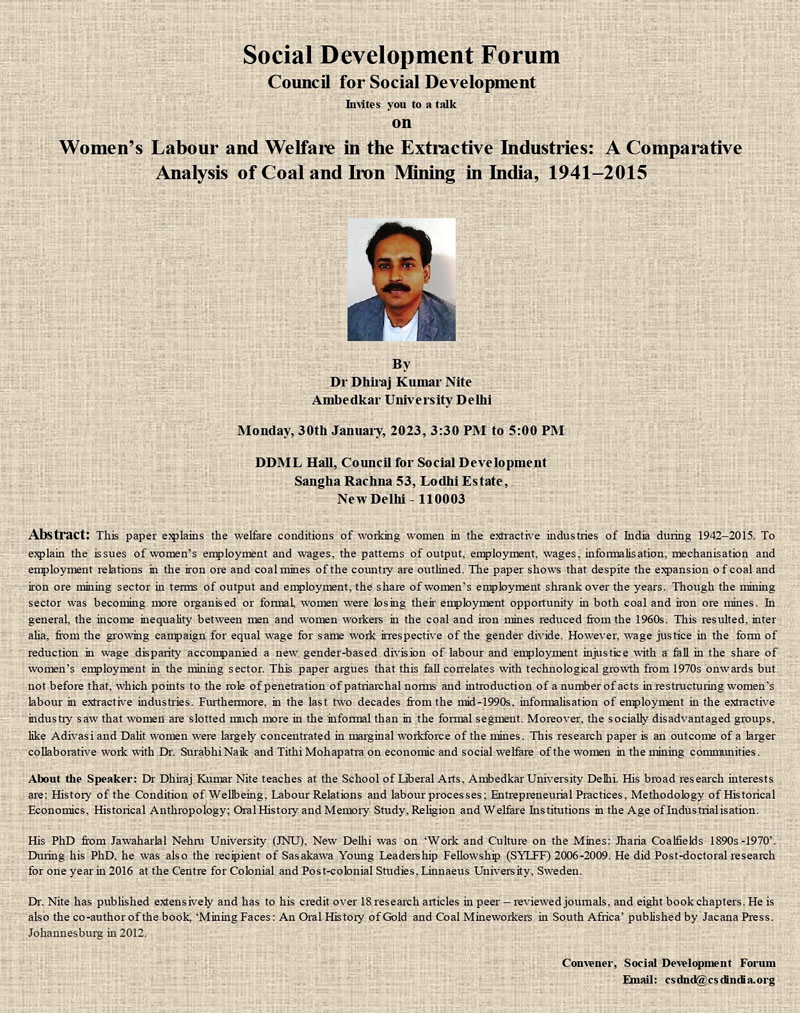
5th Social Change Annual Lecture on “Ecosystem People, Biosphere People, Ecological Refugees”
Date and Time: 23 January, 2023
Time: 6.30 PM (IST)
